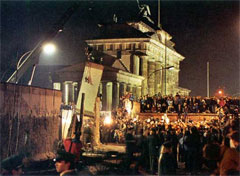Societal Change for Eastern Europe and Asian Upheaval (1990-2004)

Berlin Wall coming down November 9, 1989
Poland: Prudence and Prosperity
The fall of the Berlin wall in 1989 and the dissolution of the Soviet Union in 1991 enabled the IMF to become a (nearly) universal institution. In three years, membership increased from 152 countries to 172, the most rapid increase since the influx of African members in the 1960s.
In order to fulfill its new responsibilities, the IMF's staff expanded by nearly 30 percent in six years. The Executive Board increased from 22 seats to 24 to accommodate Directors from Russia and Switzerland, and some existing Directors saw their constituencies expand by several countries.
The IMF played a central role in helping the countries of the former Soviet bloc transition from central planning to market-driven economies. This kind of economic transformation had never before been attempted, and sometimes the process was less than smooth. For most of the 1990s, these countries worked closely with the IMF, benefiting from its policy advice, technical assistance, and financial support.
By the end of the decade, most economies in transition had successfully graduated to market economy status after several years of intense reforms, with many joining the European Union in 2004.
Asian Financial Crisis
In 1997, a wave of financial crises swept over East Asia, from Thailand to Indonesia to Korea and beyond. Almost every affected country asked the IMF for both financial assistance and for help in reforming economic policies. Conflicts arose on how best to cope with the crisis, and the IMF came under criticism that was more intense and widespread than at any other time in its history.
From this experience, the IMF drew several lessons that would alter its responses to future events. First, it realized that it would have to pay much more attention to weaknesses in countries’ banking sectors and to the effects of those weaknesses on macroeconomic stability. In 1999, the IMF—together with the World Bank—launched the Financial Sector Assessment Program and began conducting national assessments on a voluntary basis. Second, the Fund realized that the institutional prerequisites for successful liberalization of international capital flows were more daunting than it had previously thought. Along with the economics profession generally, the IMF dampened its enthusiasm for capital account liberalization. Third, the severity of the contraction in economic activity that accompanied the Asian crisis necessitated a re-evaluation of how fiscal policy should be adjusted when a crisis was precipitated by a sudden stop in financial inflows.
Debt relief for poor countries
During the 1990s, the IMF worked closely with the World Bank to alleviate the debt burdens of poor countries. The Initiative for Heavily Indebted Poor Countries was launched in 1996, with the aim of ensuring that no poor country faces a debt burden it cannot manage. In 2005, to help accelerate progress toward the United Nations Millennium Development Goals (MDGs), the HIPC Initiative was supplemented by the Multilateral Debt Relief Initiative (MDRI).
- Cooperation and reconstruction (1944–71)
- The end of the Bretton Woods System (1972-81)
- Debt and painful reforms (1982–89)
- Societal change for Eastern Europe and Asian Upheaval (1990-2004)
- Globalization and the Crisis (2005 - present)
- Who we are
- Statutes and Decisions
- Evaluation and Audit
- Corporate Citizenship
- More Resources
